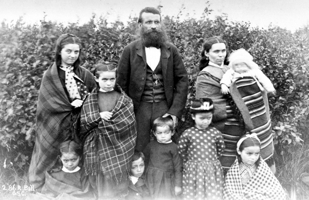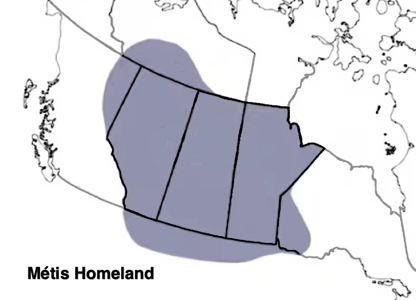
|
Folk Dance Federation of California, South, Inc.
|

|
CLICK AN IMAGE TO ENLARGE
The Métis are a distinct Indigenous people with a unique history, culture, language, and way of life. The Métis Nation is comprised of descendants of people born of relations between First Nations women and European men. The offspring of these unions were of mixed ancestry. Over time a new Indigenous people called the Métis resulted from the subsequent intermarriage of these individuals.
They have a shared history and culture, deriving from specific mixed European (primarily French, Scottish, and English) and Indigenous ancestry, which became distinct through ethnogenesis by the mid-18th century, during the early years of the North American fur trade.

Their language is called Michif. In the 21st century, Michif was spoken by some 800 individuals in the United States (Turtle Mountain Reservation, North Dakota) and Canada (scattered locations). The word Métis, which means "mixed" in French, can be used of any aboriginal (First Nation) person of mixed descent, but the Métis who are of mixed French and Cree descent are the only speakers of Michif. There are several varieties of Michif in Canada.
The Métis once traversed North America's interior in Red River carts, hunted bison with military precision, danced and jigged to spirited fiddle rhythms, wore brightly adorned embroidered clothing as well as sashes or shawls, spoke their own unique language, prayed to the Bon Dieu/Kitchi-Manitou and to their patron saint, St. Joseph, and even had their own werewolf.
Métis Elders or "Old People" have always transmitted cultural knowledge to younger generations through oral tradition. From this oral tradition emerged a rich storytelling culture that blended various First Nations motifs, such as the tricksters Wisahkecahk and Nanbush, with French-Canadian ones, such as Chi-Jean (from Ti-Jean), le diable (the Devil as a dog or handsome stranger), and le rou garou (from loup garou, a werewolf), a person who fell out of the Creator's favor. Le rou garou, however, was not just a werewolf since it had the attributes of the Cree trickster and could change into a variety of forms; rou garou stories were told to ensure that youth behaved themselves, particularly during Lent. From this storytelling tradition emerged a talent for creating nicknames, many of which often began with chi or "little," from a dialectal pronunciation of French petit.
Métis culture has always been festive and celebrated with great joie de vivre. The Métis style of dancing to fiddle tunes was very similar to their Celtic and French-Canadian antecedents, but seamlessly weaved in faster-paced First Nations footwork and rhythms such as in traditional drumming. These traditions vary among families and communities: for instance, the "Red River Jig," the signature fiddle tune and dance of the Métis, has many different versions and step patterns. House parties, focusing on jigging, dancing and fiddle playing, were a constant feature throughout Métis history, the climax of revelry being the réveillon (New Years' Eve). During such times of celebration, Métis women prepared a feast that included les beignes (fried bread), la galette (bannock), les boulettes (meatballs), le rababou (stew), and molasses cakes.
The Métis are also heirs of a vibrant material culture which emphasized the floral motif in bead, quill work, and embroidery. After adapting the design from the Grey Nuns in the 1810s, generations of Métis women produced countless objets d'art for their loved ones, for decoration, and for sale to non-Indigenous collectors.